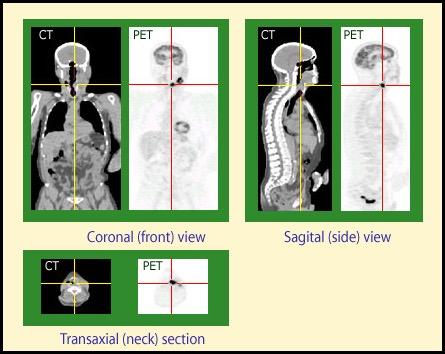Nuclear imaging
Nuclear imaging complements medical imaging diagnoses based on X-rays or gamma rays, coming from an external source.
Radioactive atoms as spies on the living world
In nuclear imaging, gamma rays are produced by the decay of radioactive atoms (markers) incorporated into a radiopharmaceutical product called a tracer, which is chosen to attach itself selectively to the organ or tumor to be explored. Radioactive atoms awaiting decay behave like ordinary atoms. When introduced into living matter, they follow the path of the atoms of their chemical species. When their disintegration occurs, it signals their presence. The gamma rays then emitted emerge from the human body. Their detection makes it possible to locate their origin. The examinations require an infinitesimal quantity of radioactive atoms that act as markers or tracers. Radioelements used as markers to be attached to the organ or part of the body to be diagnosed during the examination.
Scintigraphies
The most common examinations are called scintigraphies, because the detection cameras initially used scintillation detectors. Gamma cameras are at the origin of bone, thyroid, heart, brain, kidney and lung scans, offering a valuable range of diagnoses that other techniques cannot provide.

PET diagnostics: positron emission tomography
A second type of nuclear imaging diagnosis is that offered by positron emission tomography or PET. PET cameras use positive electron emitting radioelements (positrons) such as fluorine-19. The positrons, which are antimatter particles, practically disappear on the spot. The annihilation of these positrons generates a pair of characteristic gamma rays that are detected. The fluorine-19 is fixed on areas of high cellular activity. The PET camera, by locating hot spots of cellular activity, is valuable for the early detection of cancers. One advance has been to associate the PET camera with a scanner. This is the PET-SCAN. The scanner provides a geography of the body or organ to be examined, while the PET scan shows the hot spots, such as cancer cells. Still rare a few years ago, this screening device is now in great demand.
